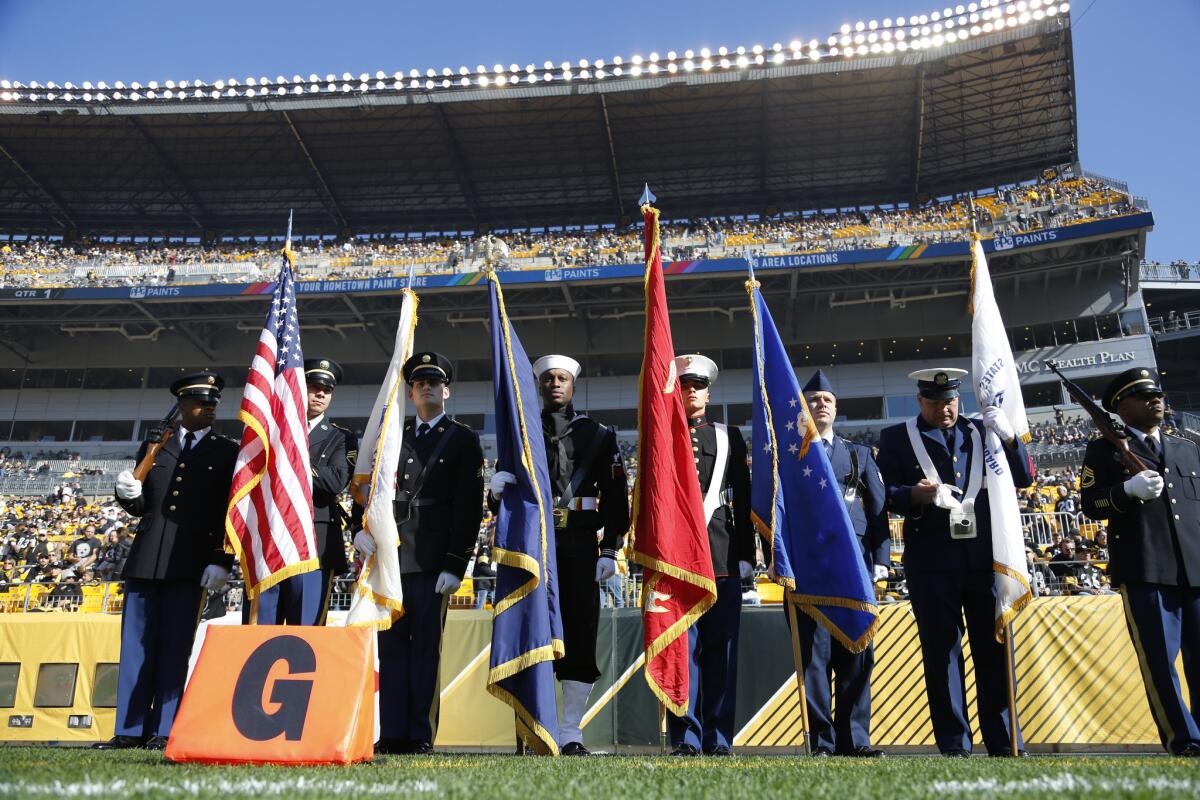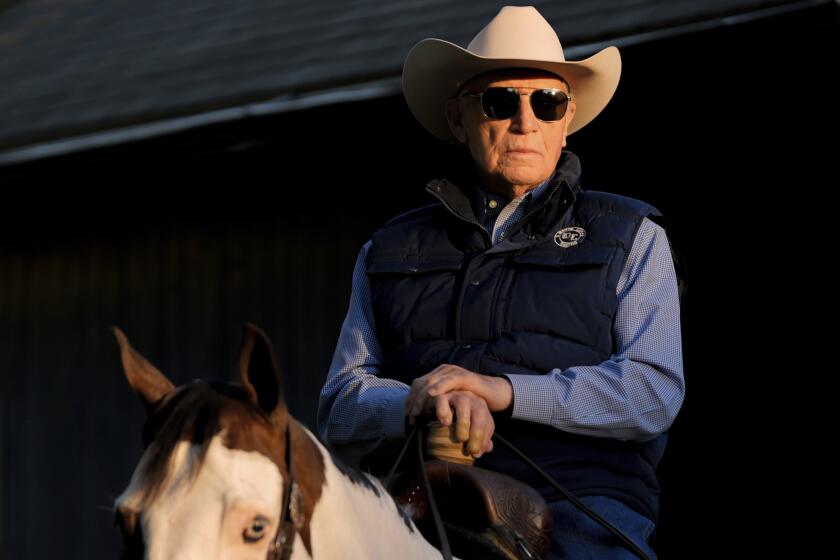A tidbit tribute (unpaid) to Malamud, Murray and Twombly

Local members of the armed forces participate as the color guard before the start of an NFL game between the Pittsburgh Steelers and the Oakland Raiders on Nov. 8.
- Share via
Time for one last notes-column tribute to the late, great Allan Malamud, sport’s journalism’s titan of the tidbit:
Feeling a bit silly after reading Nathan Fenno’s recent story in The Times about “paid patriotism”?
The lumps in our throats were surely real, as game after game we watched giant American flags unveiled on playing fields in tribute to our troops. The public address announcers always intoned our feelings. This is to honor our protectors. Because of them, we can sit in comfortable seats on warm nights and eat hot dogs.
Now we find out these moments weren’t born totally out of the goodness of our pro teams’ hearts. They are getting paid, by the Defense Department. With our tax money, $6.8 million in the last four years by one account. What is presented as pure love of country is, instead, a promotion, a military recruitment tool.
In many ways, it is less despicable on the part of the Defense Department than it is on the part of our pro teams, who have allowed us to believe this is all altruistic. They are cashing hard-earned checks of the same taxpayers who are in the stands and generally already being overcharged just to sit there.
Somewhere, the image presents itself of an NFL owner chatting with his general manager and saying, “You know, Joe, if we could just get a few more big flags and couple of Air Force flyovers, I think we can extend our quarterback’s contract two more years…”
::
Wes Welker is 34 years old and may be on the field again Sunday for the St. Louis Rams when they play the Chicago Bears. Welker has been a star receiver for Tom Brady and the New England Patriots and for Peyton Manning and the Denver Broncos. He also has had so many concussions we’ve lost count.
The question here isn’t whether he can help the Rams. It is whether he will know the names of his family by age 50.
::
Temple played a great game against Notre Dame two weeks ago and got beat. The Owls had numerous injuries and could easily have been a team depleted of manpower and heart going into the next game. Final score: Temple 60, Southern Methodist 40. Know this: Temple is no overrated fluke.
::
One of college football’s best players is Stanford’s Christian McCaffrey. His genes speak volumes, as our Chris Dufresne pointed out the other day.
Dad is former Stanford and Broncos star Ed McCaffrey. Mom Lisa is a former Stanford soccer player. Grandpa is Dave Sime, the Olympic sprinter from Duke who won a silver medal in the 100 meters in Rome in 1960 after losing a photo finish to Armin Hary of Germany. Sime’s best Olympic chance might have been 1956, but he badly tore a muscle in a meet at the Coliseum two weeks before the Olympic Trials.
Usually lost in any story about Sime, now 79 and living in Florida, is that he turned down pro sports offers to pursue a career as an eye surgeon. Among his patients were Richard Nixon, Ted Williams and Mickey Mantle.
Oh yes, and one notable sports columnist for The Los Angeles Times, who suffered a detached retina fixed by Sime. That allowed Jim Murray to write several thousand more columns on these pages and eventually win a Pulitzer Prize.
::
American Pharoah, the face of horse racing this year, with a Triple Crown and a Breeders’ Cup Classic title, has retired to stud. Estimates are that he will be sent to the breeding shed around 200 times next year, with each trip costing the owner of the mare $200,000. That’s a $40-million year.
Bob Baffert, American Pharoah’s trainer, looking back on his equine star’s hard travel, tough races and endless training as a racer in 2015, says, “He may have to work harder next year.”
::
In a Malamud-dedicated column that mentions Murray, we close with the story of another sportswriting great, the late Wells Twombly. And we do so with a current news peg: The Russians have recently been exposed as Olympic cheaters.
Again.
It was the 1976 Olympics in Montreal, and U.S. reporters were housed at the University of Montreal. A member of that sportswriting clan was Twombly, star of the San Francisco Examiner staff, a columnist whose way with words rivaled even Red Smith and Murray.
Also, as was the trend among the sporting typists in those days, Twombly had a way with the demon rum.
One night, we returned to find Twombly both hung over and ecstatic. While the rest were off chasing bike racers and rowers, Twombly had stumbled out of bed with a headache, heard a ruckus nearby and went to check it out. The University of Montreal was hosting just one event — the epee competition in the men’s modern pentathlon.
It turned out the ruckus was about a cheating Soviet, who had used a concealed electrical device to falsely trigger a recorded hit on an opponent.
His name was Boris Onishenko, a three-time world champion competing in his last Olympics at 38.
Twombly reported it perfectly, and wondered aloud to some of us, with a twinkle in his eye, if he had missed any good stories by not getting up early and chasing all around Montreal.
Onishenko, quickly labeled by the sarcastic press “Disonishenko,” was whisked from Canada, tossed out of the Red Army, fined 5,000 rubles and disappeared into the anonymity of driving a cab in Kiev. There are no reports of his death, so he would be 78.
Twombly died the next year, at 41.
Longtime readers of newspaper sports pages remember him with respect and awe, as they do Murray and Malamud.
Follow Bill Dwyre on Twitter @DwyreLATimes
More to Read
Go beyond the scoreboard
Get the latest on L.A.'s teams in the daily Sports Report newsletter.
You may occasionally receive promotional content from the Los Angeles Times.











